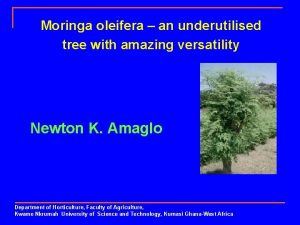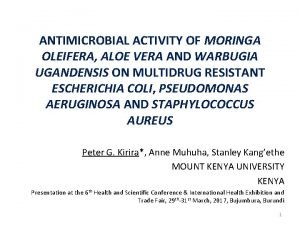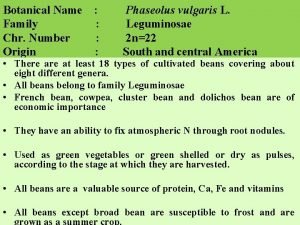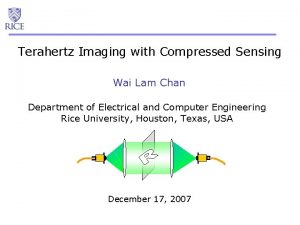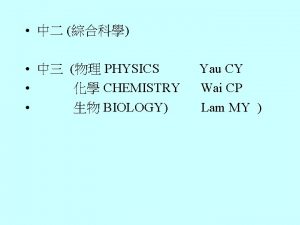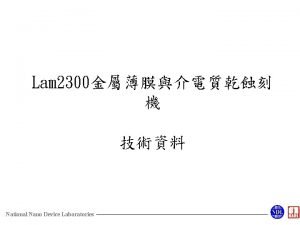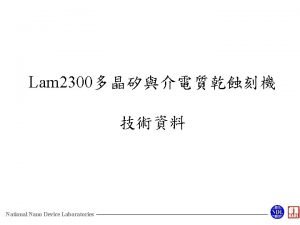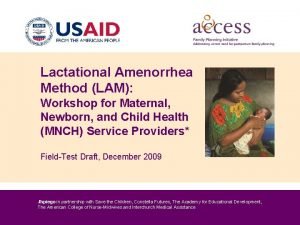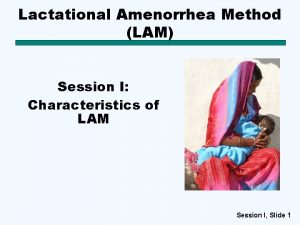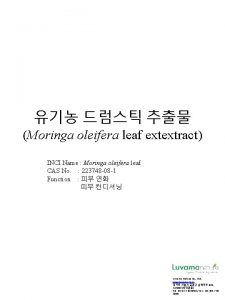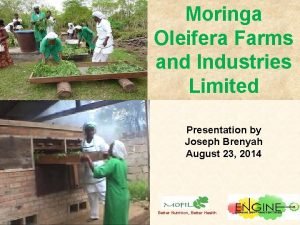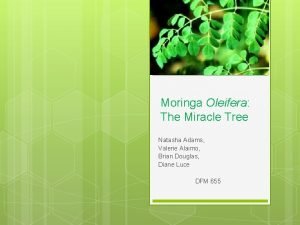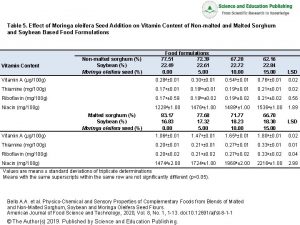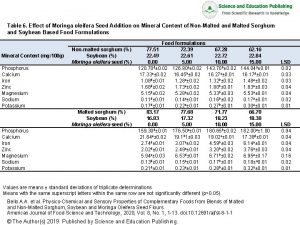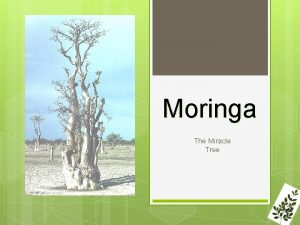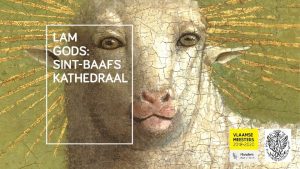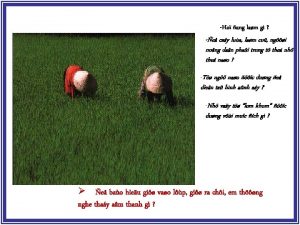MORINGA Moringa oleifera Lam Family Moringaceae Origin India






















- Slides: 22

MORINGA (Moringa oleifera Lam) Family: Moringaceae Origin: India


Nutrient Compostion of Moringa: A complete Mineral Package

• In India cultivated mainly in the south (Tamil Nadu, Karnataka, Kerala, and Andhra Pradesh) • Generally raised as a backyard tree for daily use. • Fast growing, drought tolerant and easily adapted to climatic conditions varied • Pods are consumed as a popular vegetables in South Indian cuisines and valued for their distinct flavour. • Grown for its tender pods, leaves and flowers.

CULTIVARS Perennial: • Jaffna (Yazhpanam) • Chavakacheri murungai producing fruits 90 -120 cm long. • Chemmurungai (red tipped fruits), flower throughout year and heavy yielding. • Palmurungai and • Puna Murungai ANNUAL MORINGA VARIETIES ØKM-1 ØPKM-1 Ø PKM-2 ØGKVK-1 ØGKVK-2 ØGKVK-3 ØDhanaraj ØKonkan

Climate • • Grown from sea level to 1800 a. m. s. l. Dry, warm and semi-arid conditions are congenial. Performs best at 25 -350 C. Highly susceptible to frost and high temperature exceeding 400 C. Soil • • Sandy loam soils Most suitable p. H around 6. 5 Good drainage Water logging and heavy clay soils are not suitable. Propagation/Sowing • • Perennial Moringa - stem cuttings (limb cutting)(100 -150 cm with 14 -16 cm dia) Annual Moringa - seed. Seed rate: 500 g/ha is sown in nursery. Seedlings of height 15 -20 cm are ready for planting in 6 -8 weeks of sowing.

Planting season ØPerennial : 5 m x 5 m (400 trees/ha) ØAnnual: 2 m x 2 m (2500 plants/ha) ØHigh density planting: 6666 plants/ha@1. 5 x 1. 0 m Manures and fertilizers v. Moringa trees are generally grown successfully without fertilizers. v. FYM 12 -15 t/ha (10 -15 kg/plant) v 135: 23: 45 g g NPK/ pit at the time of sowing. After pinching 45: 15: 30 g/ha NPK/plant + 25 kg FYM or compost is applied within a week after cutting back every year. Pinching Annual: 60 th day after sowing or 75 cm height Perennial: medium pruning at 70 cm from the tip.

Annual Moringa After care § Pinching terminal bud on central leader stem at 75 cm height (2 months after sowing). § Promote growth of many lateral branches and reduce tree height. § Pinching reduces the damage due to heavy wind and makes harvesting much easier. Perennial Moringa § Pollarding or cutting down plant to a height of 1 m from the ground level can be practised after one year to allow ratooning of crop. § Pollarding or pinching following harvesting is recommended to promote branching, increase pod production and facilitate harvesting. § It is done during winter (Nov-Dec) when no fruit production is seen. § Crop can be retained for 3 -4 years with regular pruning once in a year. Irrigation § Hardy and drought tolerant crop § Require irrigation only in hot summers once in a week. § Annual moringa responds well to irrigation and yield can be doubled.

First harvesting: 180 Days After Sowing Harvesting Period: ü Annual: six months from sowing. Peak flowering & fruiting. Jan. May; June-Sep ü Perennial: March-June and Sep-Oct Yield: ü Perennial: 500 -600 pods/tree/year(4 -5 years after planting) ü Annual: 250 -400 pods/tree/year ü Fruit available for harvest in 7 -8 months. Ratooning: Trees are cut back 90 cm from ground level Ratoon crop duration: 3 years Industrial byproducts: Moringa leaf powder, seed oil and cake

Ivy Gourd (Coccinia grandis) Origin- India

• Tropical vine grown for its small edible fruits • Herbaceous perennial climber Uses: ØYoung leaves and long slender stem tops are cooked and eaten as a pot herb or added to soups. ØYoung and tender green fruits are used as raw in salad or cooked. ØJuice of roots and leaves , and Red ripe fruit are useful treatment for diabetes. ØParticularly of significance when “Hidden Hunger” is of concern- a rich source of carotene, folic acid, iron and Protein. Climate and soil ØNeeds warm and humid climate with an ideal temperature of 20 -30° C ØProduces fruits through out the year in South India but plant remain dormant during winter in Northern India. ØGrown in light, medium (loam) and heavy soils and require well drained soils


ØImportant varieties are Indira Kundru 5, Indira Kundru 35, Arka Neelachal Kunkhi, Arka Neelachal Kirti, Arka Neelachal Sabuja, kasha Suphal ØPropagated by stem cutting. ØStem cutting with 12 -15 cm long, pencil thickness having 5 -6 leaves are taken. ØPlanted in basins of 60 cm diameter dug 3 m apart and put 5 kg FYM. ØPlanting in June-July or February-March ØPlant population should have at least 10% male plants. ØVines are often trained on Bower or Bamboo structures. Ø 60: 40 kg NPK/ha. Half N + Full P and K at planting time and rest of N in 4 equal splits. ØRequires good quantity of water, but cannot tolerate stagnation ØPruning of vines is most important. ØRepeated pruning of vines must be done when look a bit weak and leaves turn yellow i. e. every 3 to 4 months to maximize yield (newly developing vines produce more flowers & yield). ØFlowering start after 50 -60 days of planting and average yield is 10 -15 t/ha.



Pruned stump Newly developing vines, 2 to 3 weeks after pruning



Curry Plant/Leaf Botanical Name: Murraya koenigii (L. ) Family: Rutaceae Habitat: India


ØAlthough found in the wild, also widely cultivated for its aromatic leaves and as an ornamental. ØUsed for culinary and medicinal properties. ØAn important ingredient in South Indian and Sri Lankan cuisine ØSpicy leaves of plants are used extensively for seasoning and flavouring dishes. ØLeaves are rich source of Ca but its nutritional availability is affected due to presence of oxalic acid in high concentration. ØImportant varieties are Sen Kaampu, DWD-1 and DWD-2 ØRed sandy loam with good drainage is the ideal soil though can be grown in wide range of soils. ØTolerate maximum temperature 26 -37° C ØPropagation through small suckers from base of tree or by root cutting or by seed.

ØSeed should be pulped with in 3 -4 days of fruit collection and is sown in nursery. ØFYM 20 t/ha. ØPlanting at 1. 2 -1. 5 m in 30 cm 3 pit while for low fertile soil spacing is 90 cm X 90 cm. ØPlanting is done in May-June. ØTerminal bud is allowed to grow up to 1 m height and later cut off to encourage basal branching to maintain plant in a bushy state (Topping) and to encourage maximum leaf production. ØPruning or topping is also a part of harvesting of leaves. ØLeaf quality decreased if the plant is allowed to flower and fruit. ØFirst harvest starts 10 -12 months after planting and yield is 250 -400 kg leaves/ha ØAfter 5 years, yield is 5000 kg/ha once in 3 months.
 Hukum bacaan alif lam qomariah
Hukum bacaan alif lam qomariah Sta je moringa
Sta je moringa Moringa biodiesel
Moringa biodiesel Lipogenesis y lipolisis
Lipogenesis y lipolisis Moringa project
Moringa project Os 3 2011
Os 3 2011 Moringa vs aloe vera
Moringa vs aloe vera History of pharmaceutical legislation in india
History of pharmaceutical legislation in india Family origin questionnaire
Family origin questionnaire Family name origin
Family name origin Conclusion on topic family
Conclusion on topic family Periodic table families
Periodic table families Binuclear family vs blended family
Binuclear family vs blended family Dr wai-lam chan
Dr wai-lam chan Qarshi davlat universiteti ingliz tili fakulteti
Qarshi davlat universiteti ingliz tili fakulteti Cp lam
Cp lam Bài thơ mưa làm lũng
Bài thơ mưa làm lũng Menipiskan sebutan huruf ra
Menipiskan sebutan huruf ra Lam module
Lam module Lam2300
Lam2300 Lam method
Lam method Lam method
Lam method Caylua designs
Caylua designs




